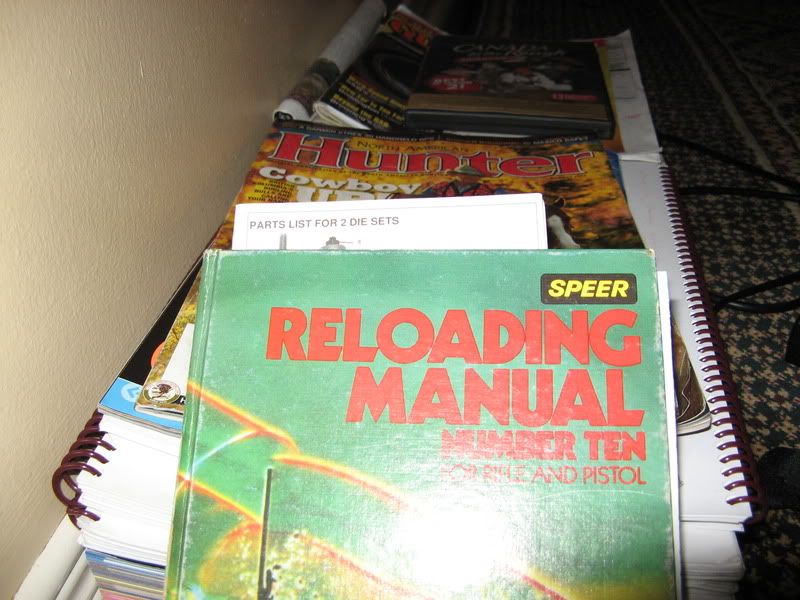Ammo tests
Posted: Mon Sep 26, 2011 10:36 am

Today my friend Dave and I went to the range to compare some of our handloaded ammunition to commercial ammunition.
We found some surprising results.
How a chronograph works:
The function of a ballistic chronograph is to give the velocity of a bullet shot over its sensors.
There are two photo sensitve sensors mounted at a predetermined distance from each other. When the bullet passes over the sensors, the presense of the shadow (or decrease in light) is recorded. The time difference in the recoding of the two shadows is noted and transalated into a velocity in feet/sec. This is displayed in an LCD window in the front of the chronograph. The white curved peices over the chrono are sun screens held up by Aluminum rods. They increase the possibilty of the shadow of the bullet being detected in direct sunlight.
From the bullet velocity recorded, a number of results can be interpolated. The formulae to calculate these are available in many location on the web and in most of the reloading handbooks. Our standard setup is to set the chronograph at 10 ft. from the muzzle (close enough to muzzle velocity) to keep it away from muzzle blast. We record our results on paper and use an Excel spread sheet to calculate the results on the spot. Results that we look for right away are average Muzzle Velocity, average Muzzle Energy and the standard deviation for the velocity.
Some results:
.357 Magnum (6 inch S&W 686)
Remington 125 gr. Jacketed Soft Point. M.E. approx 684 ft. lbs., M.V. 1569 fps
Federal 158 gr. HydraShok M.E. approx 580 ft. lbs, M.V. 1279 fps
Hornady 125 gr. FTX. M.E. 626 ft. lbs, M.V. 1500 fps
handload: 125 grain Hornady XTP, 21.5 grains of Winchester 296 powder.
M.E. approx. 705 ft. lbs, M.V. 1592 fps
According to the reloading manuals, there is room to increase the charge here, which should see and even greater increase in M.V. and M.E.
.40 S&W (CZ P-06)
Winchester (white box) 165 gr. Flat point, M.E. approx 471 ft lbs, M.V. 1100.6 fps
handload: 165 gr JHP, 6.5 gr. Power Pistol powder, M.E. 321 ft. lbs, M.V. 965.19 fps
Nice mild load. Some room to go up in charge, Max charge is listed at 7.8 grains of Power Pistol
9mm Luger (SIG P225/Tanfoglio TZ-75)
Hornady Critical Defense, 115 grain FTX, M.E. 277 ft. lbs, M.V. 1041 fps
handload: 115 gr. Rainier HP, 6.0 gr. Power Pistol powder, M.E. 324.65 ft. lbs, M.V. 1127.3 (shot with SIG 225 pistol)
handload: 115 gr. Rainier HP, 6.0 gr. Power Pistol powder, M.E. 301.13 ft. lbs, M.V. 1085.7 (shot with Tanfoglio TZ75)
Interesting to see the differneces here. Both pistols have the same barrel length. 6.0 grains is still a light load. Max load is still a ways away.
Summary: (most of this is common knowledge but it is nice to see actual figures)
1. Most probably due to liability reasons and the vast number of older guns in circulation, many manufacturers loadings are conservative.
2. Velocities listed on the box may not match what you attain out of your gun. The manufacturers test barrel length may be different from yours.
3. Different guns can produce different results with the same ammunition.
4. Some manufacturers ammunition is not loaded with the same care as others and this can produce large standard deviation numbers which in turn will affect group size. For example one manufacturers low end practice ammo produced a Std. Dev. of 288.44 whereas one batch of my handloaded ammo (with each charge weighed) produced a Std Dev. of 15.61. You can make your own assumption of groups sizes that will be attained with each regardless of the shooter or handgun.
5. Higher velocity will not always give you tight groups. A lot depends on the weight of the bullet used and the twist rate of the rifling.
Notes:
Manufacturers do not release powder info; i.e. type of powder or the weight of the charge. Some manufacturers use blended powders that result in reduced flash and maybe (?) attenuate the recoil and report. This is especially true for self defense loads.
One goal (for us) is to exceed the performance of the common commercial loadings without producing pressures that the gun and/or cartridge casing cannot handle. Rather than getting exceedingly technical let me just say that there are plenty of signs that can be observed in the spent cartridge as you start approaching the pressure limits of the casing. Most modern guns are strong enough to allow higher pressures than the factory loadings.
Another goal is to produce lower powered ammo for practice/plinking and introducing newcomers into the sport. Obviously this ammo must be capable of achieving good groups with the handgun in question.
